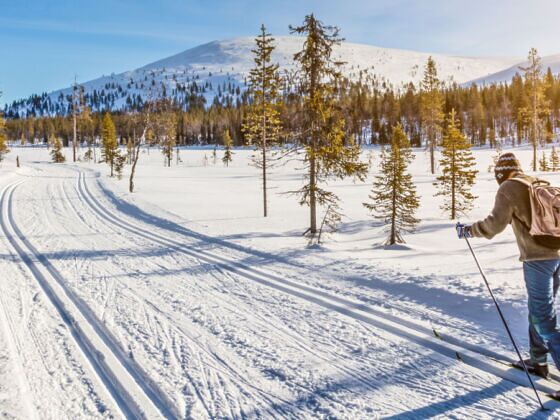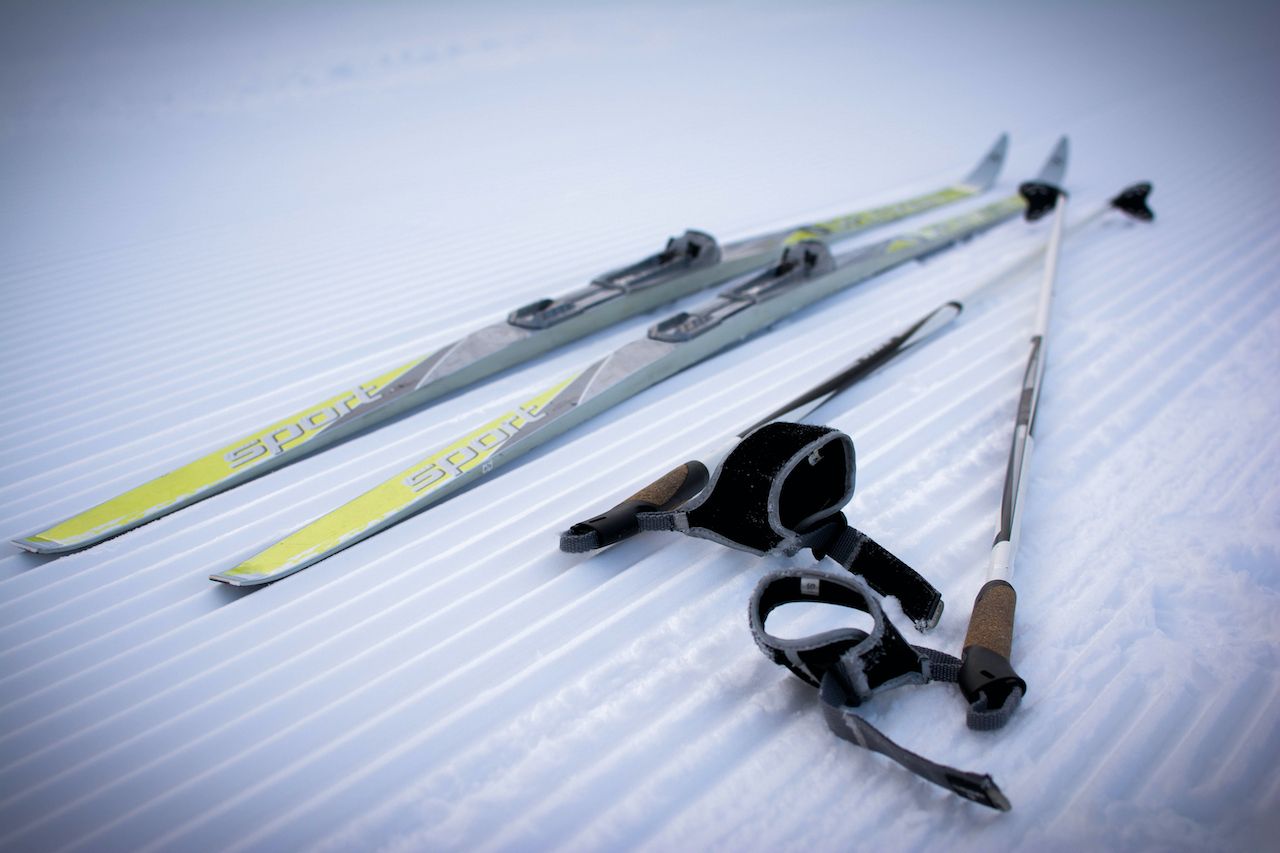Traversing snow-covered forests on long, skinny planks of wood has been a Scandinavian custom for 5,000 years. In northern Russia the concept first evolved as transport as early as 6,000 BC, according to records from archeologist Grigoriy Burov. It may have first evolved in Central Asia where cave drawings dating back 8,000 years show figures on skis.


Cross-Country Skiing Is a Perfect Winter Workout. Here's What to Know.
In any case, what was first used as a practical mode of transportation across snowy frontiers didn’t become a recreational activity until the 1800s, with the first known organized competition taking place in Norway in 1842. A decade later, a Norwegian immigrant who’d taken a job as a mail carrier in the United States began using Nordic skis to bring mail from northern California into Idaho, unknowingly introducing cross-country skiing to a young country that would in the coming decades embrace it and its downhill-angled cousin, alpine skiing.
Fast forward 170 years to the COVID-19 pandemic. Nordic skiing is about to have a new moment as the ideal activity for winter recreation when avoiding physical contact is a social mandate. There is no crowding onto ski lifts or dining in packed cafeterias, no sharing nor worry of a high-speed collision with another skater on the ice. No winter activity, except snowshoeing, offers such potential for solitude among snow-blanketed pines. Many established trail systems have fire-heated warming huts to provide a place to stop for lunch and mark the midpoint of the ski tour, and best of all, you’ll never pay $200 for a ticket to access them. Nordic skiing is the perfect outdoor activity for this winter. Here’s how to get started and where to go once you’re suited up.
Grab this Nordic skiing gear before heading out

Photo: Monika Mulec Skitek/Shutterstock
Nordic — or cross-country — skiing consists of two forms: classic skiing, in which the skier moves slowly in a manner that resembles power walking, and skate skiing, where the motion is performed at a forward tilt more like speed skating. Start in classic mode and be ready for a workout. You may not be climbing a mountain or flying down a steep slope, but a day of Nordic action is sure to get the heart pumping.
Get yourself a pair of Nordic touring skis, long and skinny and perfect for the grooved tracks that mark most cross-country ski trails. Sizing your Nordic skis follows an oddly complicated formula. It’s your height in inches multiplied by 2.6 with another 15 inches added to that — and then the final answer is noted in centimeters.
Fortunately, a sales rep at any respectable Nordic ski retailer can save you the trouble of doing that math in your head. All you need to know is that your skis are going to be too long to fit in your car but not too tall to store in the garage. A pair of beginner skis and poles such as the Whitewoods Crosstours retail for under $200, while a pair of the top-tier Salomen QSTs can list as high as $550. Nordic ski poles, if not included with your skis, are available at most winter-focused outdoor retail shops and run between $20 and $50.
You’ll also need a pair of dedicated Nordic ski boots. In contrast to downhill ski boots, Nordic boots are far more comfortable. They’re lower cut, relieving you of the tight pressure around the calves and ankles that downhill boots are known for. They’re also cheaper — you can get a brand new pair of Fischer XJ Nordic boots for about the cost of a dinner out for two. On the high end, a pair of Alpina Alaska boots runs about $250.
Once you have skis, boots, and poles, the rest of the gear you’ll need can be found in the gear closet of any winter recreationist: a waterproof parka, a warm hat that covers the ears, ski pants, and waterproof gloves. A thermos full of hot cider or coffee doesn’t hurt, either.
The best spots to try nordic skiing this winter

Photo: Christopher Tipton/Shutterstock
One of the sport’s biggest draws is that it doesn’t require steep mountains or expensive lift tickets — just plenty of snow and enough room to stretch the legs. If you live in a city and want to practice before heading out to an established trail system, try a few laps at a local public golf course or park. You likely won’t be the only one there since, across the snowy states, it’s not uncommon for urban green spaces to be converted into groomed cross-country ski trails for the winter.
When you’re ready to step further afield, browse the directory of Nordic ski areas available from xcski.org. The organization lists location and contact information for Nordic tracks across the US and parts of Canada. If you live in or are visiting a region with downhill skiing, check the websites of nearby mountains as they may offer groomed cross-country paths as well. Many popular downhill ski resorts offer adjacent Nordic tracks, including destination resorts such as Stowe in Vermont and Crested Butte in Colorado.
Nordic-specific ski areas tend to be family-friendly and can usually be accessed either free of charge or with a small contribution to support the area’s upkeep. Many national parks also offer cross-country trails, and Nordic racing is common (and often crazy) across the world. Here are six standouts from across the country:
1. Trapp Family Lodge — Vermont
Vermont’s Trapp Family Lodge is the best place to actually feel like you’re Nordic skiing in the woods of Scandinavia. The country’s first dedicated Nordic center hosts about 60 miles of maintained trails rated from beginner level to experts only, with an on-site bierhall waiting for post-trail revelry and a lodge at which to dry your boots overnight.
2. Methow Trails — Washington
With 130 miles of trail accessible from more than half a dozen start points, Washington’s Methow Trails is the largest cross-country trail system in the United States. The surrounding valley and town of Winthrop are an ideal winter trip from anywhere in the Pacific Northwest as the region’s sole Nordic skiing “destination resort.”
3. Maine Huts & Trails — Maine
Maine Huts & Trails hosts 50 miles of groomed track including multiple trails with a bit of incline. Because of the hut system, it is possible to take a multi-day ski tour from hut to hut, overnighting in remote cabins secluded from modern conveniences.
4. Lapland Lake — New York
Lapland Lake in the Adirondacks is New York State’s destination cross-country center. The center maintains 23 miles of trail along with dedicated snowshoe routes, a tubing hill, and ice skating.
5. Grand Mesa — Colorado
With expansive views and little incline, flat-topped mountains are perfect for nordic skiing. Colorado’s Grand Mesa — the world’s largest flat-topped mountain — hosts 30 miles of groomed track accessible from two different trailheads. The Grand Mesa Nordic Council maintains the trail system and offers lessons and annual races that draw skiers from across Colorado and beyond.
6. Cross Country Ski Headquarters — Michigan
Nowhere in the United States does cross-country skiing exist like it does in northern Michigan. With ample snow and open space, you could pass an entire winter taking day excursions from Traverse City or Petoskey to nearby trail systems and still not have covered everything on offer. Outside the small town of Roscommon, Cross Country Ski Headquarters is the center of it all with 11 miles of groomed trails, an on-site gear shop, and even lessons and guided ski tours led by certified professionals.